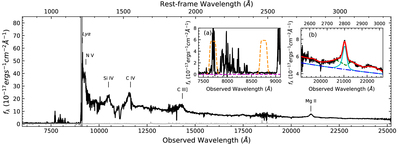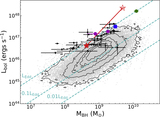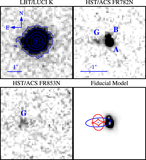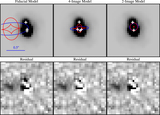Image Details

Caption: Figure 1.
Combined optical and near-infrared spectrum of the lensed quasar J0439+1634 at z = 6.51. The optical portion of the spectrum is from the Binospec instrument on the 6.5 m MMT telescope and the LRIS instrument on the 10 m Keck I telescope. The near-infrared portion of the spectrum is from the GNIRS instrument on the 8.2 m Gemini-North Telescope. The proximity zone around the quasar is denoted by the gray shaded area blueward of Lyα; its size (Rp = 3.61 ± 0.15 Mpc) is >2× smaller than for other luminous quasars at z ∼ 6.5 (Wu et al. 2015; Mazzucchelli et al. 2017), suggesting that the intrinsic ionizing flux is much lower. Insert (a) shows the spectrum in the Lyα forest region. A faint continuum is clearly detected in the darkest region of the quasar Gunn-Peterson trough, suggesting the presence of a foreground galaxy. Orange dashed lines are the traces of the HST/ACS ramp filters used to image the lensing galaxy and quasar (images shown in Figure 3). Insert (b) shows the Mg II region of the quasar spectrum. The red line is the best-fit spectrum when including a power-law continuum, Balmer continuum, and Mg II+Fe II emission. The best-fit redshift based on Mg II is 6.511 ± 0.003. The best-fit FWHM of the Mg II line is 2924 ± 188 km s−1, yielding an SMBH mass (McLure & Dunlop 2004) of (4.93 ± 0.56) × 109 M⊙ before correction for lensing magnification.
Copyright and Terms & Conditions
© 2019. The American Astronomical Society. All rights reserved.






